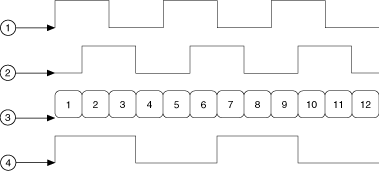Scaled Encoder Signal
The scaled encoder signal is an edge-sensitive signal that is used to track cumulative forward progression of the quadrature encoder Phase A and Phase B signals. The scaled encoder signal is derived by applying a divide factor to the raw positional signal that is encoded between Phase A and Phase B.
All NI image acquisition devices expect the raw positional signal to be encoded with x4 encoding. The scaled encoder signal can be used as a line trigger, as a timebase for pulse generation, and it can be driven out on a trigger line for external usage. The following figure illustrates the scaled encoder signal that is produced when using a divide factor of six.
|
|
| 1 Phase A Signal | 3 Position |
| 2 Phase B Signal | 4 Scaled Encoder Signal |
NI image acquisition devices that support multiple ports have a unique scaler per port. The unique scaler allows you to simultaneously acquire from multiple line scan cameras using different line rates that are all synchronous to the same quadrature encoder. Some NI image acquisition devices also support querying the absolute position counter value. Refer to the image acquisition device documentation to determine if the device supports querying the absolute position counter.
Refer to the Quadrature Encoder Overview for more information about quadrature encoders.
